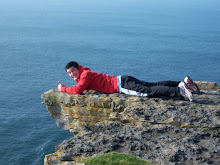Recording Software
I'm sure everyone out there has their preferred way of doing things- including software preferences for recording. Although there are dozens of options available for professional quality results, I'd like to recommend a few software music production programs that have worked well for me. I will only post those products that I have used extensively, therefore you know my knowledge and opinion is based on real experience with the product. Keep in mind some software is platform exclusive to Mac or PC. However the majority is cross-platform.
Ableton Live
This versatile piece of music software can be used in so many different applications from DJs to remixes to sampling. It it driven by a powerful mixer with two views the standard horizontal track view, or the session view which is columns of clips that can be played in any order and arranged in realtime. One of the greatest features is the instrument and effects window at the bottom. It shows the signal level in MIDI velocity and audio pre and post effects.
DJs will find the crossfader assignment (A/B buttons) easy to use for live mixes and in the studio. For the control freaks (or anyone with a midi controller, usb/firewire audio interface or control surface), the way to implement these controls in Live couldn't be simpler. Simply identift the parameter you want to control thru your hardware controller, say the Master Volume. By clicking the Key Map button, every parameter is highlighted orange and can be controlled. Choosing one parameter, then click on the MIDI Map to identify the controller for the Master Volume. You have now successfully set up a control for the Master Volume. With most MIDI controllers, they have presets of parameters, making swichting between sets where different parameter automations are required.
Musicians and DJs alike have been complementing or even focusing their performances around Live for a few years now. At $499 for the boxed version, it is worth every penny. Also the Operator synth, a native integrated mappable synth in Live can be bought for a discounted price with Live.Steinberg Cubase
In the highly competitive market of multitrack computer software, Cubase has always had their place in the game. With several versions of their renowned Cubase software from LE, to SE to SX, there are levels of knowledge and breadth of capability for all producers. Cubase also comes bundled with many pieces of hardware these days, such as the Alesis MultiMix Firewire mixers. Combining the analog inputs with an intuitive firewire interface, Cubase works seamlessly the mixer routing inputs and making recording up to 16 channels simultaneously easy. From experience I'd tend to doubt Cubase as I only saw it being used on PCs, but know I can attest that Cubase performs great on my MacBook Pro. If I had a larger multichannel interface like the MultiMix from Alesis, I would definately use Cubase everytime for recording. When I try Cubase more, I'll update to give the results of comparison testing with other software.Digidesign Pro Tools
Usually "Pro Tools" and "Industry standard" are used in the same sentence, yet recent releases by other software companies have gotten a foot in the door of the music production software market held tightly by Digidesign. Pro Tools recently partnered with M-Audio to offer a more affordable piece of software for home musicians, called Pro Tools M-Powered. It has some limitations compared to the HD and LE versions, but the has plently for the beginner Pro Tools user. Similar is the Mbox system, a 2 channel USB interface with Pro Tools LE. I interened at a professional recording studio for 5 months in the beginning if 2006, and they used the Pro Tools HD system. The interface is straighforward, setting up channels and routing couldn't be easier. The Sony Oxford plugin suite integrated extremely with the recording. Most impressive was the power of Pro Tools- no lag whatsoever.




